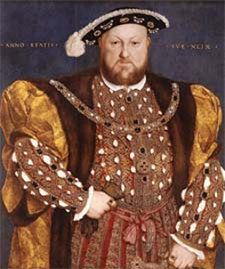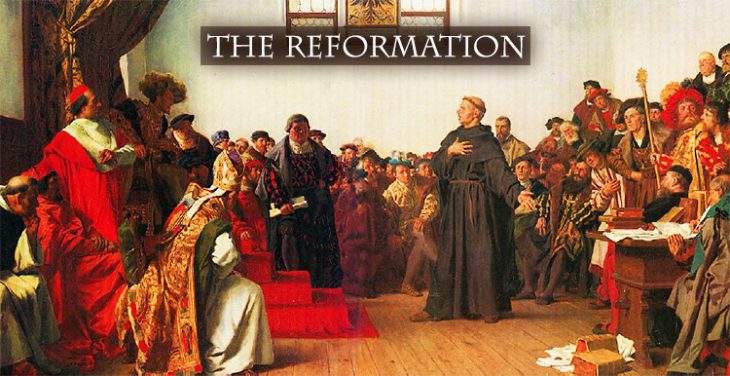William Tyndale
The next key individual in the effort to produce an English Bible was a remarkable man named William Tyndale (c.1494-1536).9 In fact, he ultimately proved to be the most important person in the whole process, as we shall see.
Tyndale was a genius who was fluent in eight languages. He was the leading scholar of Greek at Cambridge University when he decided to translate the New Testament into English. When he could not get the approval of the Church for his project, he moved to the Continent and took up residence in Germany where he finished his translation in 1525. Four years later he began translating the Old Testament.
Tyndale’s translations were the first in English to be based directly on Greek and Hebrew texts. His English New Testament was the first to be printed, making it available for widespread distribution. Copies were smuggled into England, resulting in Tyndale being declared a heretic. He further enraged English authorities when he wrote and published an attack in 1530 on King Henry VIII’s divorce.

William Tyndale
In 1535, Tyndale was betrayed by a friend and arrested in Brussels, Belgium, where he was imprisoned for a year before he was tried for heresy and then was strangled and burned at the stake. His last words were, “Lord! Open the King of England’s eyes.” Within four years his prayer was answered when the King ordered four translations of the Bible to be published in English, all of which were based on Tyndale’s work.10
The Coverdale Bible
During the year Tyndale was imprisoned, two of his disciples completed translating the Old Testament into English. They were Myles Coverdale (c.1488-1569) and John Rogers (c. 1505-1555). Although Tyndale had based his translation of the Pentateuch (the first five books of the Old Testament) on Hebrew texts, Coverdale and Rogers translated from Martin Luther’s German text (completed in 1534) and the Latin Vulgate.

Myles Coverdale
Coverdale and Rogers took what they had done and combined it with Tyndale’s complete New Testament and his partial Old Testament translations to produce what came to be called the Coverdale Bible.11 It was published in 1535.
The Great Bible
Meanwhile, King Henry VIII had broken with Rome in 1534 over his divorce of Catherine of Aragon, and he was anxious to provide an official Bible for his new Anglican Church. Accordingly, the Archbishop of Canterbury hired Myles Coverdale for the task, and he produced in 1539 what came to be known as the Great Bible.12 Its name was based on its size since it measured over 14 inches in height.
This Bible was the first “authorized edition” to be published in England. The King ordered that it be distributed to every church and chained to each pulpit. He also ordered that a reader be provided so that the illiterate could hear the Word of God.13

Henry VIII
The Matthew-Tyndale Bible
Coverdale’s collaborator on the Coverdale Bible, John Rogers, who operated under the pseudonym, Thomas Matthew, continued working on the Old Testament, determined to produce an English text based solely on Hebrew sources. He combined his work with the New Testament produced by Tyndale and published the Matthew-Tyndale Bible in 1549.
This was the first English language Bible to be based entirely on Hebrew and Greek texts.
Four years later, in 1553, the eldest daughter of King Henry VIII ascended the throne, determined to restore England to Roman Catholicism. She was crowned Queen Mary I, and she immediately launched a severe religious persecution which ultimately resulted in almost 300 dissenters being burned at the stake, including John Rogers.14 “Bloody Mary’s” attack on the Reformers prompted a mass exodus to Europe.
The Geneva Bible

The Geneva Bible
Many of those who fled Mary’s fury went to Geneva, Switzerland where John Calvin granted them asylum. There they began working on a new English translation. William Whittingham (c.1524-1579) headed up the effort and oversaw the work of a skilled team of translators and biblical scholars which included Myles Coverdale.
In 1560 they produced The Geneva Bible which became one of the most historically significant translations of the Bible into English.15 It served as the primary Bible of the Protestant Reformation Movement and was the Bible used by William Shakespeare, Oliver Cromwell, John Milton, John Knox, John Donne, and John Bunyan. It was the first Bible to be brought to America, being transported across the ocean on the Mayflower.
The text of the Bible was not much different from the English versions that preceded it. In fact, more than 85% of the language came from Tyndale. What set it apart was its format and the study aids that were incorporated into it:
- It was the first English Bible with text that was divided into numbered verses.
- Extensive cross-referencing of verses was supplied.
- Each book was preceded with a summary introduction.
- Visual aids like maps, tables, and woodcut illustrations were added.
- It contained topical and name indexes.
- It featured an elaborate system of marginal notes designed to explain the meanings of verses.
Because of all these features, The Geneva Bible has often been referred to as the first study Bible. It was enormously popular, and it quickly replaced all other Bibles. Its popularity continued for decades after the King James Version was released in 1611.
The Bishop’s Bible
But The Geneva Bible was not popular among the rulers of England. Queen Mary had been succeeded by her sister, Elizabeth I, who returned England to the Protestant fold, but Elizabeth was a devout believer in the Divine Right of Kings, and the marginal notes of The Geneva Bible were strongly opposed to both monarchy and the institutional church. This led to the production in 1568 of a new authorized Bible called The Bishop’s Bible, which was a revision of The Great Bible of 1539. The Bishop’s Bible was never able to gain much acceptance among the people.16

Elizabeth I
The Douay-Rheims Bible
Meanwhile, the Roman Catholic Church had decided to give up its resistance to translations. Realizing they had lost the battle, they decided that if the Bible was going to be available in English, they might as well produce an official Catholic version.
They used the inaccurate Latin Vulgate as their source text, and in 1582 they published what was called the Douay-Rheims Bible.17 The New Testament was published in 1582. The Old Testament was completed over 30 years later in 1610. This version contained notes that were very polemical in nature, designed to counter the claims of the Protestant Reformation.
In the third segment on this series teaching on the Bibles of the Reformation, we’ll look at the ascendancy the popular King James Version.
Notes
9) Wikipedia, “William Tyndale,” http://en.wikipedia.org/wiki/William_Tyndale.
10) Ibid., page 4.
11) Widipedia, “Coverdale Bible,” http://en.wikipedia.org/wiki/Coverdale_Bible.
12) Wikipedia, “Great Bible,” http://en.wikipedia.org/wiki/Great_Bible.
13) Jeffcoat, “English Bible History,” page 4.
14) Wikipedia, “Mary I of England,” http://en.wikipedia.org/wiki/Mary_I_of_England.
15) Wikipedia, “Geneva Bible,” http://en.wikipedia.org/wiki/Geneva_Bible.
16) Jeffcoat, “English Bible History,” page 6.
17) Wikipedia, “Douay-Rheims Bible,” http://en.wikipedia.org/wiki/Douay%E2%80%93Rheims_Bible.







